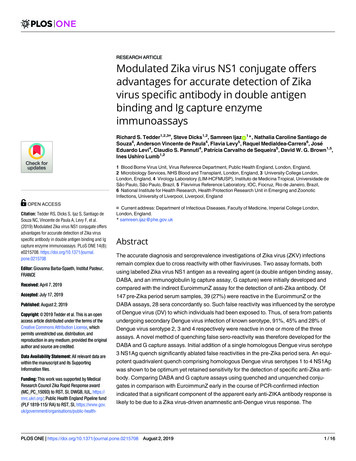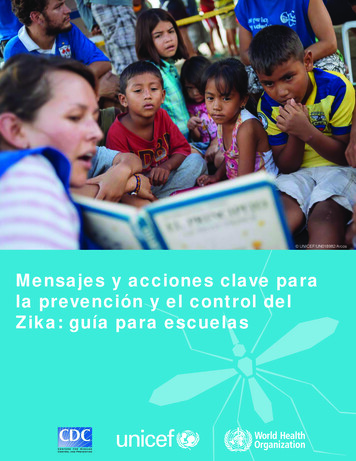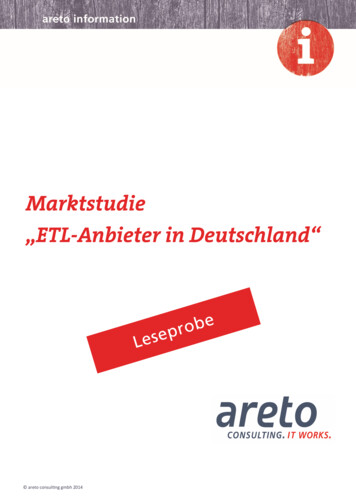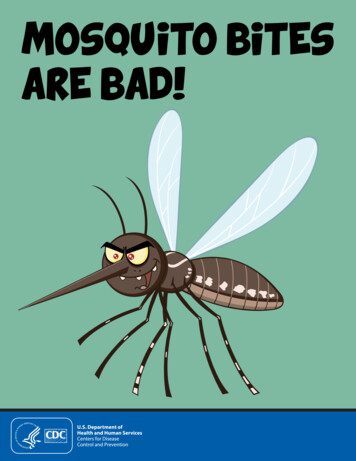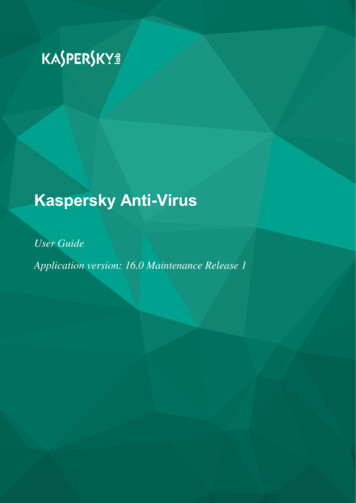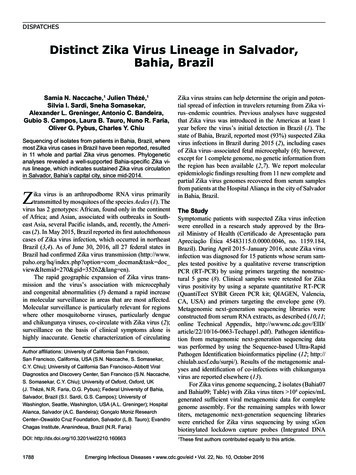
Transcription
DISPATCHESDistinct Zika Virus Lineage in Salvador,Bahia, BrazilSamia N. Naccache,1 Julien Thézé,1Silvia I. Sardi, Sneha Somasekar,Alexander L. Greninger, Antonio C. Bandeira,Gubio S. Campos, Laura B. Tauro, Nuno R. Faria,Oliver G. Pybus, Charles Y. ChiuSequencing of isolates from patients in Bahia, Brazil, wheremost Zika virus cases in Brazil have been reported, resultedin 11 whole and partial Zika virus genomes. Phylogeneticanalyses revealed a well-supported Bahia-specific Zika virus lineage, which indicates sustained Zika virus circulationin Salvador, Bahia’s capital city, since mid-2014.Zika virus is an arthropodborne RNA virus primarilytransmitted by mosquitoes of the species Aedes (1). Thevirus has 2 genotypes: African, found only in the continentof Africa; and Asian, associated with outbreaks in Southeast Asia, several Pacific islands, and, recently, the Americas (2). In May 2015, Brazil reported its first autochthonouscases of Zika virus infection, which occurred in northeastBrazil (3,4). As of June 30, 2016, all 27 federal states inBrazil had confirmed Zika virus transmission (http://www.paho.org/hq/index.php?option com docman&task docview&Itemid 270&gid 35262&lang en).The rapid geographic expansion of Zika virus transmission and the virus’s association with microcephalyand congenital abnormalities (5) demand a rapid increasein molecular surveillance in areas that are most affected.Molecular surveillance is particularly relevant for regionswhere other mosquitoborne viruses, particularly dengueand chikungunya viruses, co-circulate with Zika virus (2);surveillance on the basis of clinical symptoms alone ishighly inaccurate. Genetic characterization of circulatingAuthor affiliations: University of California San Francisco,San Francisco, California, USA (S.N. Naccache, S. Somasekar,C.Y. Chiu); University of California San Francisco–Abbott ViralDiagnostics and Discovery Center, San Francisco (S.N. Naccache,S. Somasekar, C.Y. Chiu); University of Oxford, Oxford, UK(J. Thézé, N.R. Faria, O.G. Pybus); Federal University of Bahia,Salvador, Brazil (S.I. Sardi, G.S. Campos); University ofWashington, Seattle, Washington, USA (A.L. Greninger); HospitalAlianca, Salvador (A.C. Bandeira); Gonçalo Moniz ResearchCenter–Oswaldo Cruz Foundation, Salvador (L.B. Tauro); EvandroChagas Institute, Ananindeua, Brazil (N.R. Faria)DOI: http://dx.doi.org/10.3201/eid2210.1606631788Zika virus strains can help determine the origin and potential spread of infection in travelers returning from Zika virus–endemic countries. Previous analyses have suggestedthat Zika virus was introduced in the Americas at least 1year before the virus’s initial detection in Brazil (1). Thestate of Bahia, Brazil, reported most (93%) suspected Zikavirus infections in Brazil during 2015 (2), including casesof Zika virus–associated fetal microcephaly (6); however,except for 1 complete genome, no genetic information fromthe region has been available (2,7). We report molecularepidemiologic findings resulting from 11 new complete andpartial Zika virus genomes recovered from serum samplesfrom patients at the Hospital Aliança in the city of Salvadorin Bahia, Brazil.The StudySymptomatic patients with suspected Zika virus infectionwere enrolled in a research study approved by the Brazil Ministry of Health (Certificado de Apresentação paraApreciação Ética 45483115.0.0000.0046, no. 1159.184,Brazil). During April 2015–January 2016, acute Zika virusinfection was diagnosed for 15 patients whose serum samples tested positive by a qualitative reverse transcriptionPCR (RT-PCR) by using primers targeting the nonstructural 5 gene (8). Clinical samples were retested for Zikavirus positivity by using a separate quantitative RT-PCR(QuantiTect SYBR Green PCR kit; QIAGEN, Valencia,CA, USA) and primers targeting the envelope gene (9).Metagenomic next-generation sequencing libraries wereconstructed from serum RNA extracts, as described (10,11;online Technical Appendix, happ1.pdf). Pathogen identification from metagenomic next-generation sequencing datawas performed by using the Sequence-based Ultra-RapidPathogen Identification bioinformatics pipeline (12; http://chiulab.ucsf.edu/surpi/). Results of the metagenomic analyses and identification of co-infections with chikungunyavirus are reported elsewhere (13).For Zika virus genome sequencing, 2 isolates (Bahia07and Bahia09; Table) with Zika virus titers 104 copies/mLgenerated sufficient viral metagenomic data for completegenome assembly. For the remaining samples with lowertiters, metagenomic next-generation sequencing librarieswere enriched for Zika virus sequencing by using xGenbiotinylated lockdown capture probes (Integrated DNA1These first authors contributed equally to this article.Emerging Infectious Diseases www.cdc.gov/eid Vol. 22, No. 10, October 2016
Distinct Zika Virus Lineage, Bahia, BrazilTable. Clinical information for isolates from serum samples of patients with acute symptomatic Zika virus infection*160-nt single-end250-nt paired-end ZikaViralmetagenomic readsvirus–specific enrichmentPatientGenbankZikaZika virusload,age,Collection accessionvirusqRT-PCR copies/GenomeMean foldGenomeMean foldIsolatey/sexdate†no.RT-PCRCtmLrecovery, %‡ coveragerecovery, %‡ coverageBahia01 72/F 2015 May KX101066Pos34.61,04223.10.465.316,288.216Bahia02 37/M 2015 May KX101060Pos32.54,08626.00.473.420,045.85Bahia03 35/M 2015 May KX101061Pos32.83,2721.10.077.7220.05Bahia04 40/M 2015 Jun 15 Dec KX101063Pos33.71,9015.00.142.88,547.510Bahia07 37/F 2015 Aug KU940228 Pos13.71003,603.5ND ND 9.1 10829Bahia08U/M2015 Jul KU940227Pos33.32,47075.19.284.923,805.115Bahia09 40/F 2015 Apr KU940224 Pos29.923,12199.9841.5ND ND 25Bahia11 40/F2015 Apr KX101064PosNegNA27.80.964.028,704.127(no Ct)Bahia12 36/M 2015 May 2016 Jan KX101065PosNegNA4.60.245.43,706.825(no Ct)*Ct, cycle threshold; NA, not applicable; ND, not done; Neg, negative; Pos, positive; qRT-PCR, quantitative reverse transcription PCR; RT-PCR, reversetranscription PCR; U, unknown.†Samples were collected from Salvador in Bahia, Brazil, except for Bahia05, which was collected in Camaçari, Bahia, Brazil.‡Assumes a genome size of 10,676 nt, the size of the prototype Brazilian Zika virus strain SPH2015 (KU321639).Technologies, Redwood, CA, USA) designed to tile acrossall sequenced Zika virus genomes 10,000 nt in GenBank(http://www.ncbi.nlm.nih.gov/genbank) as of March 1,2016. Capture probes were curated for redundancy at a99% nt similarity cutoff. Enrichment was performed onthe metagenomic libraries in pools of 8 libraries (including Zika virus–negative serum sample controls) by usingthe xGen lockdown probe protocol and the SeqCap EZ Hybridization and Wash Kit (Roche, Indianapolis, IN, USA).Eleven Zika virus genomes with 40% genome recovery(mean 69.4% 2.0%) were assembled (Table). Distribution of single nucleotide variants across the 11 recoveredgenomes exhibited distinct patterns (online Technical Appendix Figure 1), indicating that the assembled genomeswere unlikely to result from cross-contamination by a single high-titer Zika virus sample.Multiple sequence alignment was performed by using MAFFT version 7 (http://mafft.cbrc.jp/alignment/software/); maximum-likelihood (ML) and Bayesian phylogenetic inferences were determined by using PhyML version3.0 (http://www.atgc-montpellier.fr/phyml/) and BEASTversion 1.8.2 (http://beast.bio.ed.ac.uk/), respectively.The best-fit model was calculated by using 2; details in onlineTechnical Appendix). Coding regions corresponding to the11 complete or partial genomes from Bahia were alignedwith all published and available near-complete Zika virus genomes and longer subgenomic regions ( 1,500 nt)of the Asian genotype as of April 2016 (mean sequencesize 8,402 nt with 1,652 distinct nucleotide site patterns).The ML phylogeny was reconstructed by using the best-fitgeneral time-reversible nucleotide substitution model witha proportion of invariant sites (GTR I). Statistical support for phylogenetic nodes was assessed by using a bootstrap approach with 1,000 bootstrap replicates. A Bayesian molecular clock phylogeny was estimated by using thebest-fitting evolutionary model (2); specifically, a GTR Isubstitution model with 3 components: a strict molecularclock, a Bayesian skyline coalescent prior, and a noninformative continuous time Markov chain reference prior forthe molecular clock rate.The isolates from patients in Salvador clustered together within 1 strongly supported clade (posterior probability1.00, bootstrap support 100%, Bahia clade C) (Figure; online Technical Appendix Figure 2). This support is notable;most Zika virus genomes in this clade are incomplete, anduncertainty is accounted for in phylogenetic inference. Thetree topology accords with previous findings (2,4,5), andtime to most recent common ancestor (TMRCA) of theepidemic in the Americas is similar to that previously estimated (2) (American epidemic clade A; Figure). The overall ML and molecular clock phylogenies exhibited manywell-supported internal nodes with bootstrap support 60%and posterior probability 0.80 (Figure; online TechnicalAppendix Figure 2), although several nodes near the ancestor of clade A were less well supported.Emerging Infectious Diseases www.cdc.gov/eid Vol. 22, No. 10, October 20161789
DISPATCHESFigure. Timeframe of Zika virus outbreaks in the Americas. A molecular clock phylogeny is shown with the Zika virus outbreak lineageestimated from complete and partial ( 1,500 nt) coding region sequences. For visual clarity, 5 basal Southeast Asia sequences(GenBank accession nos. HQ23499 [Malaysia, 1966]; EU545988 [Micronesia, 2007]; KU681082 [Philippines, 2012]; JN860885[Cambodia, 2010]; and KU681081 [Thailand, 2013]) are not displayed. Blue horizontal bars represent 95% Bayesian credible intervalsfor divergence dates. A, B, and C denote the current American epidemic, the northeastern Brazil (Maranhão sequence and Bahia), andthe Bahia clades, respectively; numbers next to the clade denote posterior probabilities and bootstrap scores in percentages. Circlesizes at each node represent the posterior probability support of that node. Taxa are labeled with the Genbank accession numbers,sampling location, and sampling date. Names of sequences generated in this study are in bold. The inset graph on the left shows theposterior probability distributions of the estimated ages (time to most recent common ancestor) for clades A, B, and C. The posteriorprobability density is plotted on the vertical axis as a function of time on the horizontal axis (tick marks designate 3-month intervals).Estimated ages were determined with BEAST version 1.8.2 (http://beast.bio.ed.ac.uk/) by using the best-fitting evolutionary model. Theposterior probability distributions were visualized by using Tracer version 1.6 (http://tree.bio.ed.ac.uk/software/tracer/). Brazil states: BA,Bahia; CE, Ceará; MA, Maranhão; PA, Pará; PB, Paraíba; RN, Rio Grande do Norte; RJ, Rio de Janeiro; SP, São Paulo. .1790Emerging Infectious Diseases www.cdc.gov/eid Vol. 22, No. 10, October 2016
Distinct Zika Virus Lineage, Bahia, BrazilThe updated phylogenetic analyses, including the newly identified clade C, suggest that Zika virus was introducedin Bahia during March–September 2014. An isolate fromMaranhão in northeastern Brazil ( 1,000 km from Bahia)is ancestral to the Bahia clade (posterior probability 1.00,bootstrap support 74%, northeastern Brazil clade B) (Figure; online Technical Appendix Figure 2). The TMRCAof clade B (comprising the Bahia clade and the Maranhãosequence) is estimated to be September 2013–April 2014,an early stage of the epidemic. This TMRCA is consistentwith the hypothesis that Zika virus in the Americas originated in Brazil (2). A previously reported sequence fromBahia (6) clustered with an isolate from Belém in the stateof Pará in northern Brazil, 3,000 km from Bahia (posteriorprobability 0.99, bootstrap support 81%) (Figure; onlineTechnical Appendix Figure 2). The patient denied historyof travel, suggesting that multiple Zika virus lineages maycirculate in Bahia.ConclusionsOur results suggest an early introduction and presence(mid-2014) of Zika virus in the Salvador region in Bahia, Brazil. Given the size of the cluster and statisticalsupport for it, this lineage likely represents a large andsustained chain of transmission within Bahia state. Mostcases of this Zika virus lineage clustered closely to a sequence from Maranhão, and we found evidence for an additional potential introduction to Bahia from Pará state.Consequently, Zika virus in Salvador during mid-2014was likely introduced from other regions in Brazil ratherthan from outside the country. Current findings of Zika virus emergence in Bahia state during mid-2014 are consistent with first-trimester viral infection in pregnant womencorresponding to the initial reported cases of fetal microcephaly, which began in January 2015 (5) and peaked inNovember 2015.Broader sampling across Bahia is needed to determinewhether the Salvador lineage (clade C) identified in thisarticle comprises most Zika virus cases in the state. Brazilcurrently faces a major public health challenge from cocirculation of Zika, dengue, and chikungunya viruses (2–4,14,15). Additional molecular surveillance in the Americas and beyond is urgently needed to trace and predicttransmission of Zika virus.614725-PATHPHYLODYN, National Institutes of Health grantsR01-HL105704 and R21-AI120977 (C.Y.C.), and a viraldiscovery award from Abbott Laboratories, Inc. (C.Y.C.).This study was made possible by the generous support of theAmerican people through the United States Agency forInternational Development Emerging Pandemic ThreatsProgram-2 PREDICT-2 (Cooperative Agreement No.AID-OAA-A-14-00102).Dr. Naccache is a researcher at the University of California,San Francisco; her interests are genomic assay developmentfor clinical infectious disease diagnosis and sequencing-basedcharacterization of emerging viruses. Dr. Thézé is a postdoctoralresearcher in computational biology at the University ofOxford, UK; he is interested in viral evolution, especially thespatiotemporal dynamics of pathogen We thank multiple researchers worldwide for permission toinclude their unpublished Zika virus genomes in our analysis.10.This study was supported in part by Fundação de Amparo aPesquisa do Estado da Bahia, the European ResearchCouncil under the European Union’s Seventh FrameworkProgram (FP7/2007-2013)/ERC grant agreement no.11.Musso D, Gubler DJ. Zika virus. Clin Microbiol Rev. 2016;29:487–524. http://dx.doi.org/10.1128/CMR.00072-15Faria NR, Azevedo Rdo S, Kraemer MU, Souza R, Cunha MS,Hill SC, et al. Zika virus in the Americas: early epidemiologicaland genetic findings. Science. .aaf5036Campos GS, Bandeira AC, Sardi SI. Zika virus outbreak,Bahia, Brazil. Emerg Infect Dis. .150847Zanluca C, Melo VC, Mosimann AL, Santos GI, Santos CN,Luz K. First report of autochthonous transmission of Zikavirus in Brazil. Mem Inst Oswaldo Cruz. 2760150192Rubin EJ, Greene MF, Baden LR. Zika virus and microcephaly.N Engl J Med. 2016;374:984–5. http://dx.doi.org/10.1056/NEJMe1601862Kleber de Oliveira W, Cortez-Escalante J, De Oliveira WT,do Carmo GM, Henriques CM, Coelho GE, et al. Increase inreported prevalence of microcephaly in infants born to womenliving in areas with confirmed Zika virus transmission duringthe first trimester of pregnancy—Brazil, 2015. MMWRMorb Mortal Wkly Rep. 2016;65:242–7. http://dx.doi.org/10.15585/mmwr.mm6509e2Giovanetti M, Faria NR, Nunes MR, de Vasconcelos JM,Lourenço J, Rodrigues SG, et al. Zika virus complete genomefrom Salvador, Bahia, Brazil. Infect Genet Evol. .2016.03.030Balm MN, Lee CK, Lee HK, Chiu L, Koay ES, Tang JW.A diagnostic polymerase chain reaction assay for Zika virus.J Med Virol. 2012;84:1501–5. http://dx.doi.org/10.1002/jmv.23241Lanciotti RS, Kosoy OL, Laven JJ, Velez JO, Lambert AJ,Johnson AJ, et al. Genetic and serologic properties of Zikavirus associated with an epidemic, Yap State, Micronesia, 2007.Emerg Infect Dis. 2008;14:1232–9. http://dx.doi.org/10.3201/eid1408.080287Chiu CY, Bres V, Yu G, Krysztof D, Naccache SN, Lee D, et al.Genomic assays for identification of chikungunya virus in blooddonors, Puerto Rico, 2014. Emerg Infect Dis. 8.150458Greninger AL, Naccache SN, Messacar K, Clayton A, Yu G,Somasekar S, et al. A novel outbreak enterovirus D68 strainassociated with acute flaccid myelitis cases in the USA (2012–14):a retrospective cohort study. Lancet Infect Dis. 099(15)70093-9Emerging Infectious Diseases www.cdc.gov/eid Vol. 22, No. 10, October 20161791
DISPATCHES12.13.14.Naccache SN, Federman S, Veeraraghavan N, Zaharia M, Lee D,Samayoa E, et al. A cloud-compatible bioinformatics pipelinefor ultrarapid pathogen identification from next-generationsequencing of clinical samples. Genome Res. 934.113Sardi SI, Somasekar S, Naccache SN, Bandeira AC, Tauro LB,Campos GS, et al. Co-infections from Zika and chikungunyavirus in Bahia, Brazil identified by metagenomic next-generationsequencing. J Clin Microbiol. In press 2016.Kraemer MU, Sinka ME, Duda KA, Mylne AQ, Shearer FM,Barker CM, et al. The global distribution of the arbovirus vectors15.Aedes aegypti and Ae. albopictus. eLife. 7Nunes MR, Faria NR, de Vasconcelos JM, Golding N, Kraemer MU,de Oliveira LF, et al. Emergence and potential for spread ofchikungunya virus in Brazil. BMC Med. 348-xAddress for correspondence: Charles Y. Chiu, University of California,San Francisco, 185 Berry St, Box # 0134, UCSF China Basin, SanFrancisco, CA 94107, USA; email: charles.chiu@ucsf.eduMay 2016: Vectorborne DiseasesIncluding: E xpansion of Shiga Toxin–Producing Escherichia coli byUse of Bovine AntibioticGrowth Promoters P rojecting Month of Birth forAt-Risk Infants after Zika VirusDisease Outbreaks G enetic Characterization ofArchived Bunyaviruses andTheir Potential for Emergencein Australia A n Operational Frameworkfor Insecticide ResistanceManagement Planning P lasmodium falciparum K76Tpfcrt Gene Mutations andParasite Population Structure,Haiti, 2006–2009 O utbreak of Middle EastRespiratory Syndrome atTertiary Care Hospital, Jeddah,Saudi Arabia, 2014 D ifferences in Genotype,Clinical Features, andInflammatory Potential ofBorrelia burgdorferi sensustricto Strains from Europe andand the United States P lasmodium falciparumIn Vitro Resistance toMonodesethylamodiaquine,Dakar, Senegal, 2014 A strovirus MLB2, a NewGastroenteric Virus Associatedwith Meningitis andDisseminated Infection S pectrum of Viral Pathogensin Blood of Malaria-Free IllTravelers Returning to Canada E xpanded GeographicDistribution and ClinicalCharacteristics ofEhrlichia ewingii Infections,United States R ickettsia parkeri Rickettsiosis,Arizona, USA A cute Human Inkoo andChatanga Virus s/issue/22/05/table-of-contents1792Emerging Infectious Diseases www.cdc.gov/eid Vol. 22, No. 10, October 2016
Eleven Zika virus genomes with 40% genome recovery (mean 69.4% 2.0%) were assembled (Table). Distribu - tion of single nucleotide variants across the 11 recovered genomes exhibited distinct patterns (online Technical Ap-pendix Figure 1), indicating that the assembled genomes were unlikely to result from cross-contamination by a sin-
